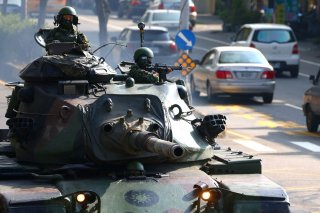The M60 Army Tank Is A Legend That Won't Retire
Introduced in 1960, the M60 quickly became the U.S. Army’s staple main battle tank throughout the Cold War.
One of the most iconic tanks of the Cold War era, the M60 Patton has proven itself over its four decades of service as a worthy predecessor to the contemporary M1 Abrams.
The project that eventually became the M60 Patton grew out of a 1950s initiative to replace the prior M48, a compelling main battle tank (MBT) that was nonetheless held back by its anemic operational range and middling armaments suite. At a time when the Soviet tank fleet appeared to be outpacing its U.S. counterpart in survivability and firepower, the U.S. Army sought a new tank platform that could go head-to-head with the likes of the Soviet T-54 in the case of a major conventional conflict in Europe.
Introduced in 1960, the M60 quickly became the U.S. Army’s staple MBT throughout the Cold War. By 1961, the fleet of American M48A3’s in Europe was replaced by the M60. The tank’s hull and armor composition was slightly revised from the M48, though the first M60 models generally retained its predecessor’s innovative turret shape. The M60’s long M68 105-millimeter gun was a noticeable improvement over the 90-millimeter M41 gun of the baseline M48, while its more powerful diesel engine supported a range of up to 500 kilometers.
The M60 platform’s key to long-lived success was its remarkable adaptability, spawning numerous revisions and derivative models that kept pace with both the changing face of modern warfare as well as parallel technological developments in the Soviet Union. Released hot on the heels of the original M60, the M60A1 introduced a revised hull and further armor improvements. The M60A2 “Starship” was less successful, boasting a forward-looking—but deeply flawed—152-millimeter Gun/Missile Launch system. The M60A2 could only fire while stationary, and the mechanical sighting system could only track one target at a time. Serious design flaws notwithstanding, the M60A2 was prone to a flood of technical malfunctions that made the tank notoriously unreliable. A large crop of M60A2’s was later converted to the new M60A3 standard, a major 1970s revision that added marginally better armor, a new ballistic computer for more streamlined targeting and engagement, thermal sights for the gunner, and numerous other electronics enhancements.
The M60 made its explosive entry during the 1973 Yom Kippur War, where it was used to great effect (under the name “Magach 6”) by Israel against a numerically superior Syrian force. Israeli-operated M60s traded blows with the comparable T-62 tank; the greater threat came from 9M14 Malyutka anti-tank missiles, which caught Israeli M60 formations by surprise on several occasions. Toward the end of its service life in the U.S. military, the M60 occupied a prominent role in the 1991 Gulf War; U.S. M60A1’s performed admirably against Iraqi T-72’s, destroying as many as one hundred enemy tanks with remarkably few combat losses in return.
The two tanks initially served alongside one another, but—following Operation Desert Storm—the M60 was phased out by the newer and more capable M1 Abrams MBT. The last U.S. M60s were retired by the late 1990s, but the Patton lives on as an export product. Thousands of M60’s remain in parts of Africa and across the Middle East, with Egypt alone having purchased over two thousand late M60 variants; other prominent contemporary operators include Yemen, Iran, and Taiwan.
Mark Episkopos is the new national security reporter for the National Interest.

